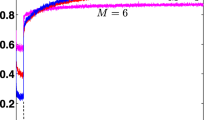Abstract
The frequency-assisted phase tracking (FAPT) is investigated extensively in comparison with the phase tracking (PT) in a Kalman filter (KF) frame to explore the role the augmented frequency measurement plays in FAPT. It is found that the FLL-assisted PLL is suboptimal in structure, while the FAPT is optimal in the minimum variance sense. Hence, the KF frame provides not only a rational method to compare the FAPT with the PT but also an insight into the effects of frequency and phase measurements on PT. The impact of the two typical discriminators, ATAN and ATAN2, on the phase tracking performance in the FAPT and the PT is studied by Monte Carlo simulations and covariance analysis. The results show that the pull-in range affects the lock-in threshold, and the linear region determines the performance under high dynamic environments. In addition, the measurement variance dominates the tracking accuracy under weak signal conditions. The phase discriminator governs the performance of the FAPT. In terms of both the tracking accuracy and the lock-in threshold, the augmented frequency measurement in the FAPT filters is very helpful in tracking the high dynamic signal, but it contributes little to the weak signal tracking.











Similar content being viewed by others
References
Bar-Shalom Y, Li XR, Kirubarajan T (2001) Estimation with applications to tracking and navigation: theory algorithms and software. Wiley, New York, pp 272–277
Curran JT (2010) Weak signal digital GNSS tracking algorithms. Ph.D. thesis, National University of Ireland, Cork
Curran JT, Lachapelle G, Murphy CC (2012) Improving the design of frequency lock loops for GNSS receivers. IEEE Trans Aerosp Electron Syst 48(1):850–868
Foucras M, Ekambi B et al. (2014) Performance study of FLL schemes for a successful acquisition-to-tracking transition. In: Proceedings of IEEE/ION PLANS 2014, May. Monterey, USA, pp 529–540
Jaffe R, Rechtin E (1955) Design and performance of phase lock circuits capable of near-optimal performance over a wide range of input signal and noise levels. IRE Trans Inf Theory 1(1):66–76
Jwo DJ (2001) Optimisation and sensitivity analysis of GPS receiver tracking loops in dynamic environments. IEEE Proc Radar Sonar Navig 148(4):241–250
Lu M, Guo SL, Gang WZ (2014) Performance analysis of a second order FLL assisted third order PLL for tracking Doppler rates. WSEAS Trans Commun 13(1):26–43
O’Driscoll C, Lachapelle G (2009) Comparison of traditional and Kalman filter based tracking architectures. In: Proceedings of European Navigation Conference 2009, May. Naples, Italy, pp 1–10
Petovello MG, Lachapelle G (2006) Comparison of vector-based software receiver implementations with application to ultra-tight GPS/INS integration. In: Proceedings of ION GNSS 2006. Institute of Navigation, September, Fort Worth TX, pp 1790–1799
Psiaki ML, Jung H (2002) Extended Kalman filter methods for tracking weak GPS signals. In: Proceedings of ION GPS 2002. Institute of Navigation, September, Portland, OR, pp 2539–2553
Roncagliolo PA, Garcia JG, Muravchik CH (2012) Optimized carrier tracking loop design for real-time high-dynamics GNSS receivers. Int J Navig Obs. doi:10.1155/2012/651039
Tang XH, Falco G, Falleti E, Presti LL (2015) Theoretical analysis and tuning criteria of the Kalman filter-based tracking loop. GPS Solut 19(3):489–503
Ward PW (1997) Using a GPS receiver Monte Carlo simulator to predict RF interference performance. In: Proceedings of ION GPS 1997. Institute of Navigation, September, Kansas City, pp 1473–1482
Ward PW (1998) Performance comparisons between FLL, PLL and a novel FLL-assisted-PLL carrier tracking loop under RF interference conditions. In: Proceedings of ION GPS 1998. Institute of Navigation, September, Nashville, USA, pp 783–795
Ward PW, Betz JW, Hegarty CJ (2006) Satellite signal acquisition, tracking and data demodulation. In: Kaplan ED, Hegarty CJ (eds) Understanding GPS, chap 5, 2nd edn. Artech House, Boston, pp 153–241
Won JH, Dotterbock D, Eissfeller B (2009) Performance comparison of different forms of Kalman filter approach for a vector-based GNSS signal tracking loop. In: Proceedings of ION GNSS 2009, September. Savannah, GA, pp 3037–3048
Won JH, Pany T, Eissfeller B (2012) Characteristics of Kalman filters for GNSS signal tracking loop. IEEE Trans Aerosp Electron Syst 48(4):3671–3681
Xu R, Liu ZZ, Chen W (2015) Improved FLL-assisted PLL with in-phase pre-filtering to mitigate amplitude scintillation effects. GPS Solut 19(2):263–276
Author information
Authors and Affiliations
Corresponding author
Rights and permissions
About this article
Cite this article
Jiang, R., Wang, K. & Wang, J. Performance analysis and design of the optimal frequency-assisted phase tracking loop. GPS Solut 21, 759–768 (2017). https://doi.org/10.1007/s10291-016-0565-6
Received:
Accepted:
Published:
Issue Date:
DOI: https://doi.org/10.1007/s10291-016-0565-6




